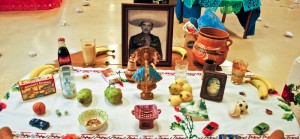Día de los muertos
|
NOGALES, México – I love contrasts and extremes: the blazing heat of the desert, and the 40 degree drop in temperature at night this time of year. Día de los Muertos, or Day of the Dead, is that kind of festival— a study of contrasts and extremes, a party of joy and sorrow, yin and yang. The Nogales cemetery, a place of sadness and grief, is today a place of singing, feasting, and marigolds everywhere. The streets are lined with booths selling bouquets of marigolds, sugar skulls, and pan dulce (sweet bread and pastries). There is the smell of roasted pork on skewers slowly dripping into the fires, and strolling guitarists and accordions are everywhere.

